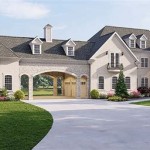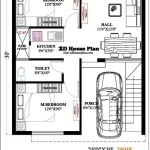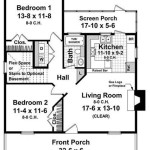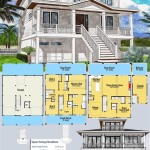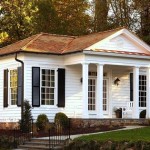Two-Bedroom House Plan Design: Optimizing Space and Functionality
The design of a two-bedroom house plan presents a unique set of challenges and opportunities. It requires careful consideration of space utilization, functionality, and aesthetic appeal, all while adhering to budget constraints and individual lifestyle needs. Unlike larger residences, two-bedroom homes demand thoughtful space allocation and efficient layout planning to maximize livability. This article explores key aspects of two-bedroom house plan design, covering considerations for various layout configurations, key room planning, and maximizing space-saving strategies.
The appeal of two-bedroom homes lies in their affordability, manageability, and suitability for various demographics. They are ideal for young couples, small families, empty nesters, and individuals seeking a comfortable yet compact living space. Furthermore, two-bedroom houses are a popular choice for investment properties, offering a balance between rental income potential and manageable upkeep costs. The design phase is critical in ensuring that the resultant house fulfills its intended purpose, whether it's a cozy family home, a convenient rental unit, or a comfortable retirement residence.
Several external factors can significantly influence the two-bedroom house plan design. Site characteristics, climate, local building codes, and neighborhood aesthetics must all be taken into account. The orientation of the house on the lot, prevailing wind direction, sunlight exposure, and potential views are all important considerations that can impact energy efficiency, comfort, and overall livability. Understanding these factors allows for the development of a design that seamlessly integrates with its surroundings while providing a functional and aesthetically pleasing living space.
Layout Considerations: Balancing Openness and Privacy
Selecting an appropriate layout is paramount in two-bedroom house plan design. The layout dictates the flow of movement within the house, the relationship between different rooms, and the overall sense of spaciousness. Common layout options include linear, L-shaped, and open-concept designs. Each layout offers unique advantages and disadvantages, and the best choice depends on the specific needs and preferences of the occupants.
A linear layout typically arranges rooms along a central hallway, providing a clear and straightforward circulation path. This layout is often suitable for narrow lots and can be highly efficient in terms of space utilization. However, it can sometimes feel less spacious than other layouts, particularly if the hallway is long and narrow.
L-shaped layouts offer a more dynamic and visually appealing design, often creating a natural division between living and sleeping areas. This configuration is well-suited for maximizing natural light and can provide better privacy for the bedrooms. The corner created by the "L" can also be used to create a sheltered outdoor living space or a private garden area.
Open-concept layouts are increasingly popular, particularly in modern two-bedroom house plans. These layouts combine the living room, dining area, and kitchen into a single, unified space. This creates a sense of spaciousness and promotes social interaction. However, open-concept layouts may require careful consideration of noise control and visual separation to maintain a comfortable living environment. Zoning can be achieved through the strategic placement of furniture, changes in flooring, and the use of partial walls or screens.
Regardless of the chosen layout, it is essential to consider the flow of movement between rooms. Ideally, the circulation path should be clear, direct, and free of obstacles. The placement of doors, windows, and furniture should be carefully considered to maximize space utilization and minimize clutter.
Key Room Planning: Optimizing Function and Comfort
Each room in a two-bedroom house plan serves a specific purpose, and careful planning is essential to ensure that each room meets the needs of the occupants. The living room should be a comfortable and inviting space for relaxation and entertainment. The kitchen should be functional and efficient, with ample storage and counter space. The bedrooms should be private and restful, with adequate closet space. And the bathroom should be well-ventilated and equipped with essential fixtures.
The living room is often the focal point of the house and should be designed to accommodate a variety of activities, such as watching television, reading, and socializing. The size and layout of the living room should be proportionate to the overall size of the house. Furniture placement should be carefully considered to create a comfortable and inviting space. Natural light is an important factor, and windows should be strategically placed to maximize sunlight exposure while minimizing glare.
The kitchen is a critical area in any house plan, and its design should prioritize functionality and efficiency. The kitchen should be laid out to minimize unnecessary steps and streamline the cooking process. The work triangle, which consists of the sink, refrigerator, and stove, should be carefully planned to optimize workflow. Ample storage space is essential, and a combination of cabinets, drawers, and shelving units should be provided to accommodate all kitchen essentials. Counter space is also crucial, and should be sufficient for food preparation and other kitchen tasks. The incorporation of a kitchen island or peninsula can significantly enhance functionality and provide additional storage and counter space.
The bedrooms should be designed as private and restful spaces. The master bedroom should be larger than the second bedroom and should include a walk-in closet and an en-suite bathroom, if possible. Both bedrooms should have adequate closet space and should be located away from noisy areas of the house. Natural light is important, but windows should be positioned to minimize direct sunlight in the morning, which can disrupt sleep. Proper ventilation is also essential to maintain a comfortable and healthy sleeping environment.
The bathroom should be well-ventilated and equipped with essential fixtures, such as a toilet, sink, and shower or bathtub. The size and layout of the bathroom should be proportionate to the overall size of the house. Storage space is important, and a vanity cabinet or shelving unit should be provided to accommodate toiletries and other bathroom essentials. Proper lighting is also crucial, and a combination of ambient, task, and accent lighting should be used to create a well-lit and functional space. Consider incorporating water-saving fixtures to reduce water consumption and lower utility bills.
Maximizing Space-Saving Strategies: Efficiency and Functionality
In two-bedroom house plan design, efficient space utilization is paramount. It is crucial to identify and implement strategies that maximize the use of available space without compromising functionality or comfort. Multi-functional furniture, built-in storage solutions, and clever layout planning can significantly enhance the livability of a small home.
Multi-functional furniture is a key component of space-saving design. Items such as sofa beds, storage ottomans, and folding tables can serve multiple purposes, allowing for greater flexibility and adaptability. For example, a sofa bed can provide a comfortable seating area during the day and a guest bed at night. A storage ottoman can provide seating and storage for blankets, pillows, or other items. A folding table can be used as a dining table or workspace and can be easily folded away when not in use.
Built-in storage solutions are another effective way to maximize space utilization. Built-in bookshelves, cabinets, and drawers can be integrated into the walls, creating ample storage space without encroaching on the floor area. Under-stair storage is often overlooked but can provide a significant amount of storage space for items such as coats, shoes, and sports equipment. Consider incorporating built-in seating with integrated storage in the living room or dining area.
Clever layout planning can also contribute to efficient space utilization. Open-concept layouts, as discussed earlier, can create a sense of spaciousness and allow for greater flexibility. Pocket doors, which slide into the wall, can save space compared to traditional swing doors. Strategically placed mirrors can create the illusion of more space and reflect light, making the room feel brighter and more open. Vertical storage solutions, such as tall shelving units, can maximize the use of vertical space.
The selection of appropriate materials and finishes can also impact the perceived size and spaciousness of a two-bedroom house. Light-colored walls and ceilings can reflect light and make the room feel brighter and more open. Using the same flooring throughout the house can create a sense of continuity and flow. Minimalist design principles, which emphasize simplicity and functionality, can help to create a clutter-free and spacious living environment.
In conclusion, designing a functional and aesthetically pleasing two-bedroom house plan requires careful consideration of various factors, including layout configuration, key room planning, and space-saving strategies. By prioritizing efficiency, functionality, and aesthetic appeal, it is possible to create a comfortable and livable home that meets the needs of a variety of occupants.

5 Small And Simple 2 Bedroom House Designs With Floor Plans

Small House Design With 2 Bedrooms

40 More 2 Bedroom Home Floor Plans

2 Bedroom House Plan Examples

6 Stunning 2 Bedroom House Plan Make My

Low Cost 2 Bedroom House Plan 70sqm Floor Plandeluxe

2 Bedroom House Plans Houzone

2 Bedroom House Plan Examples

2 Bedroom Budget House Design With Floor Plan Home Idea

Two Bedroom Small House Design Shd 2024030 Pinoy Eplans

